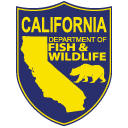 Pacific spiny dogfish are common in nearshore waters and along the continental shelf off the California coast. They are generally found to depths of around 1,200 ft., although Pacific spiny dogfish have been seen at depths of nearly 4,800 ft. They range into deeper waters off Southern California, and are often found in schools.
Pacific spiny dogfish are common in nearshore waters and along the continental shelf off the California coast. They are generally found to depths of around 1,200 ft., although Pacific spiny dogfish have been seen at depths of nearly 4,800 ft. They range into deeper waters off Southern California, and are often found in schools.
Distinguishing Characteristics
- Slate gray to brownish above, sometimes with white spots, becoming white below
- Body elongate and slender
- Head pointed
- This species and the horn shark are the only sharks along the California coast with spines at the beginning of both dorsal fins. These mildly poisonous dorsal fin spines are used for defense
Life History & Other Notes
The Pacific spiny dogfish feeds upon practically all smaller fishes such as herring, sardines, anchovies, smelts, and even small spiny dogfish. It will also eat crabs.
Most adult Pacific spiny dogfish measure from two to four ft. long. Females are larger than males and produce from three to 22 young at a time, after a gestation period of nearly two years (the longest gestation period of any vertebrate animal). Pacific spiny dogfish are long-lived; as a result, heavy fishing could reduce the population of this slow-growing, low-reproductive species quite rapidly.
Pacific spiny dogfish liver is very rich in vitamin A. During World War II, commercial harvest of this species and soupfin shark were the chief factors in the production of vitamin A for the United States and the allied nations.
Pacific Spiny Dogfish Quick Facts
Scientific Name: Squalus suckleyi
Other Common Names: dog shark, grayfish, pinback shark, green-eyed grinner
Range & Habitat: Statewide to depths of nearly 4,800 ft.
Length & Weight: To 5+ ft. and 22 lbs.
Life Span: To 80+ years
Diet & Suggested Bait: Eats smaller fishes, crabs, squid. Try fishing with feathered jigs, baited with anchovies, crabs, squid, ghost shrimp, or small live fish.
Excerpt from the California Finfish and Shellfish Identification Book. Updated Nov. 23, 2020 with information from the Marine Species Portal.

